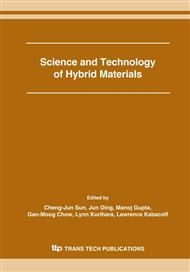[1]
I. Paz, Z. Luo, L. Radenberg, A. Haller, J. Materials Research, 10, 2842 (1995).
Google Scholar
[2]
E. Traversa, G. Gnappi, A. Montenero, G. Gusmano, Sensors and Acruators, B 31, 59(1996).
Google Scholar
[3]
E. P Patent 0114310, Carbon monoxide sensing element and process for manufacturing it, (1984).
Google Scholar
[4]
Tetsuro Seiyama, Akio Kato, Kiyoshi Fujiishi, and Masanori Nagatani, Analytical Chemistry, 34 (1962) pp.1502-1503.
DOI: 10.1021/ac60191a001
Google Scholar
[5]
S. Iijima, Nature, 354, 56 (1991).
Google Scholar
[6]
A. Chambers et al., J. Physical Chemistry, B 102, 4253 (1998).
Google Scholar
[7]
A. C. Dillon et al., Nature 386, 377 (1997).
Google Scholar
[8]
H. M. Cheng, Q. H. Yang, and C. Liu: Carbon , 39, 1447 (2001).
Google Scholar
[9]
S. M. Lee, K. S. Park, Y. C. Choi, Y. S. Park, J. M. Bok, D. J. Bae, K. S. Nahm, Y. G. Choi, C. Yu, N. G. Kim, T. Frauenheim, and Y. H. Lee, Synthetic Metals, 113, 209 (2000).
DOI: 10.1016/s0379-6779(99)00275-1
Google Scholar
[10]
A. Fujiwara, K. Ishii, H. Suematsu, H. Kataura, Y. Maniwa, S. Suzuki, and Y. Achiba: Chemical Physics Letters, 336, 205 (2001).
DOI: 10.1016/s0009-2614(01)00111-7
Google Scholar
[11]
S. Talapatra, A. Z. Zambano, S. E. Weber, and A. D. Migone, Physical Review Letters, 85, 138 (2000).
Google Scholar
[12]
P. Vincent, A. Brioude, C. Journet, S. Rabaste, S.T. Purcell, J. Le Brusq, J.C. Plenet, Journal of Non-Crystalline Solids, 311(2) (2002) 130-137.
DOI: 10.1016/s0022-3093(02)01371-6
Google Scholar
[13]
Bee-Yu Wei, Ming-Chih Hsu, Pi-Guey Su, Hong-Ming Lin, Ren-Jang Wu, Hong-Jen Lai, Sensors and Actuators B, 101 (2004) 81-89.
Google Scholar
[14]
Wei-Jen Liou, Tsung-Yeh Yang, Kuang-Nan Lin, Ching-Hong Yang, Hong-Ming Lin, Sensing Properties of CNT hybrid MOS-based Sensors, Mater. Res. Soc. Symp. Proc. Vol. 828 © 2005 Materials Research Society, pp. A2. 6. 1-A2. 6. 11.
DOI: 10.1109/nano.2005.1500808
Google Scholar


